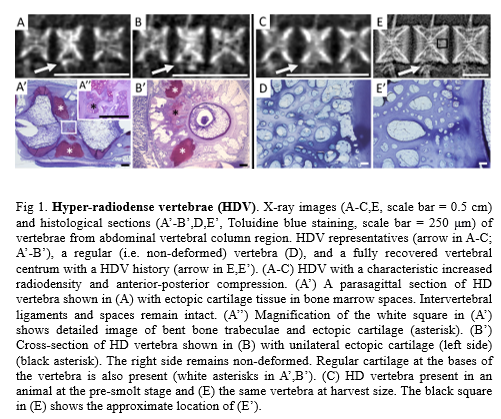A LONG-TERM DEVELOPMENTAL STUDY OF DEFORMITIES IN ATLANTIC SALMON: THE RECOVERY OF HYPER-RADIODENSE VERTEBRAE
Introduction
Hyper-radiodense vertebrae (HDV) are a frequently radiologically diagnosed deformity in Atlantic salmon Salmo salar, L. (Helland et al., 2006; Fraser et al., 2019). Increased radiodensity is caused by ectopic cartilage replacing adipose tissue in bone marrow spaces. In some cases, there are bent bone trabeculae due to anterior-posterior compression of the vertebral centrum (Helland et al., 2006). Animals have been observed with a single or up to four individual HDV. While HDV are found in freshwater stages, studies postulate that the deformity either disappears (Baeverfjord et al., 2009; Berge et al., 2009; Fjelldal et al., 2016) or exacerbates in seawater stages (Baeverfjord et al., 2009). Based on Helland et al. (2006) HDV is suggested to be related to mineral deficiency.
The specific fate of HDV in individual animals and factors inducing this deformity remain to be elucidated. This study comprised a seawater follow-up trial of animals previously subjected to deficient and excessive dietary phosphorus (P) in the freshwater (parr) stage (Drabikova et al., 2021). The study analysed HDV in individual PIT-tagged animals at (i) pre-smolt stage, (ii) seven months post seawater transfer, and (iii) at harvest size.
Materials and Methods
Atlantic salmon were studied from the parr stage (average weight 13.49 ± 1.50 g) until harvest size (average weight 4480.87 ± 1259.28 g). Parr were fed a diet with one of three levels of available P: low P (LP) (2.6 g/kg), regular P (RP) (5.9 g/kg), and high P (HP) (9.1 g/kg) for 11 weeks. Animals were subsequently PIT-tagged and fed regular commercial diets until harvest. Deformities were assessed on x-rays prior to smoltification, after seven months in seawater, and at harvest size. From each diet group, 45 animals (total no. 135) were x-rayed and assessed for HDV to progress or regress. A detailed analysis of vertebral anatomy and microstructures was conducted by Alizarin red S staining of mineralised bone and through serial histological sections.
Results and Discussion
At the pre-smolt stage, HDV were detected in 30 out of 135 animals of which 26 had a LP diet history. Despite HDV, intervertebral spaces and ligaments remain intact (Fig. 1A-C).
All identified HDV had fully recovered seven months post seawater transfer with no traces of the previous deformity (Figure 1E-E’). All recovered HDV remained non-deformed for another six months until harvest. Bone trabeculae in recovered HDV were comparable with regular, non-deformed, vertebrae (Fig. 1 D,E’).
HDV were observed to be uni-lateral, affecting the left side of the vertebra (Figure 1B’). This possibly relates to the uni-directional swimming in tanks with a small diameter (0.6 m). Bent bone trabeculae, a characteristic feature of HDV, are likely associated with soft, low-mineralised bone in animals with a LP diet history (Helland et al., 2006). This soft bone does not fracture under an increased compression load (Witten et al., 2019). Equally, bone trabeculae in HDV do not fracture but bend and are surrounded by ectopic cartilage (Fig. 1A’’).
Funding: EU-H2020-MSCA-766347.
References
Baeverfjord, G., Helland, S., Hough, C., 2009. Control of malformations in fish aquaculture: science and practice. Federation of European aquaculture producers. RapidPress, Luxembourg, 149 pages.
Berge, G.M., Witten, P.E., Baeverfjord, G., Vegusdal, A., Wadsworth, S., Ruyter, B., 2009. Diets with different n−6/n−3 fatty acid ratio in diets for juvenile Atlantic salmon, effects on growth, body composition, bone development and eicosanoid production. Aquaculture 296, 299–308.
Drábiková, L., Fjelldal, P.G., De Clercq, A., Yousaf, M.N., Morken, T., McGurk, C., Witten, P.E., 2021. Vertebral column adaptations in juvenile Atlantic salmon Salmo salar, L. as a response to dietary phosphorus. Aquaculture 736776.
Fjelldal, P.G., Hansen, T.J., Lock, E.J., Wargelius, A., Fraser, T.W.K., Sambraus, F., El-Mowafi, A., Albrektsen, S., Waagbø, R., Ørnsrud, R., 2016. Increased dietary phosphorous prevents vertebral deformities in triploid Atlantic salmon (Salmo salar L.). Aquac. Nutr. 22, 72–90.
Fraser, T.W.K., Witten, P.E., Albrektsen, S., Breck, O., Fontanillas, R., Nankervis, L., Thomsen, T.H., Koppe, W., Sambraus, F., Fjelldal, P.G., 2019. Phosphorus nutrition in farmed Atlantic salmon (Salmo salar): Life stage and temperature effects on bone pathologies. Aquaculture 511.
Helland, S., Denstadli, V., Witten, P.E., Hjelde, K., Storebakken, T., Skrede, A., Åsgård, T., Baeverfjord, G., 2006. Hyper dense vertebrae and mineral content in Atlantic salmon (Salmo salar L.) fed diets with graded levels of phytic acid. Aquaculture 261, 603–614.
Witten, P.E., Fjelldal, P.G., Huysseune, A., McGurk, C., Obach, A., Owen, M.A.G., 2019. Bone without minerals and its secondary mineralization in Atlantic salmon (Salmo salar): the recovery from phosphorus deficiency. J. Exp. Biol. jeb.188763.
